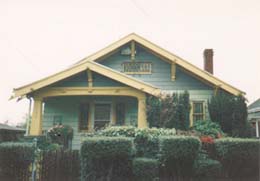Sculptor James W. Washington (1911-2000) migrated from Mississippi in 1944 to work as an electrician in the Bremerton Naval Shipyard. He was already a skilled painter and he shifted to sculpting after he moved to Seattle in 1945. He had no formal training as an artist, but he took courses through the University of Washington Extension. He also studied under local artists including Mark Tobey and Yvonne Twining Humber.
Washington's work in wood and in stone depicted animals and famous figures from American and African History. He was also active in the civil rights movement and he lectured at many colleges and universities.
Washington's home was designed and build as a bungalow in 1918 by E. A. Gustafson. Gustafson demonstrated his skill with wood in the handsome cabinets and fireplace. He and his wife Annie, a seamstress, lived in the house until 1944.
In 1965, architect William Bain designed a studio for Washington, behind the house. The two-story addition was equipped to handle some of Washington's larger works.
On January 27, 1992, the Seattle City Council designated the home and studio a Seattle Landmark because of its association with Washington and its role in the heritage of the community. Address: 1816 26th Avenue, Seattle.

